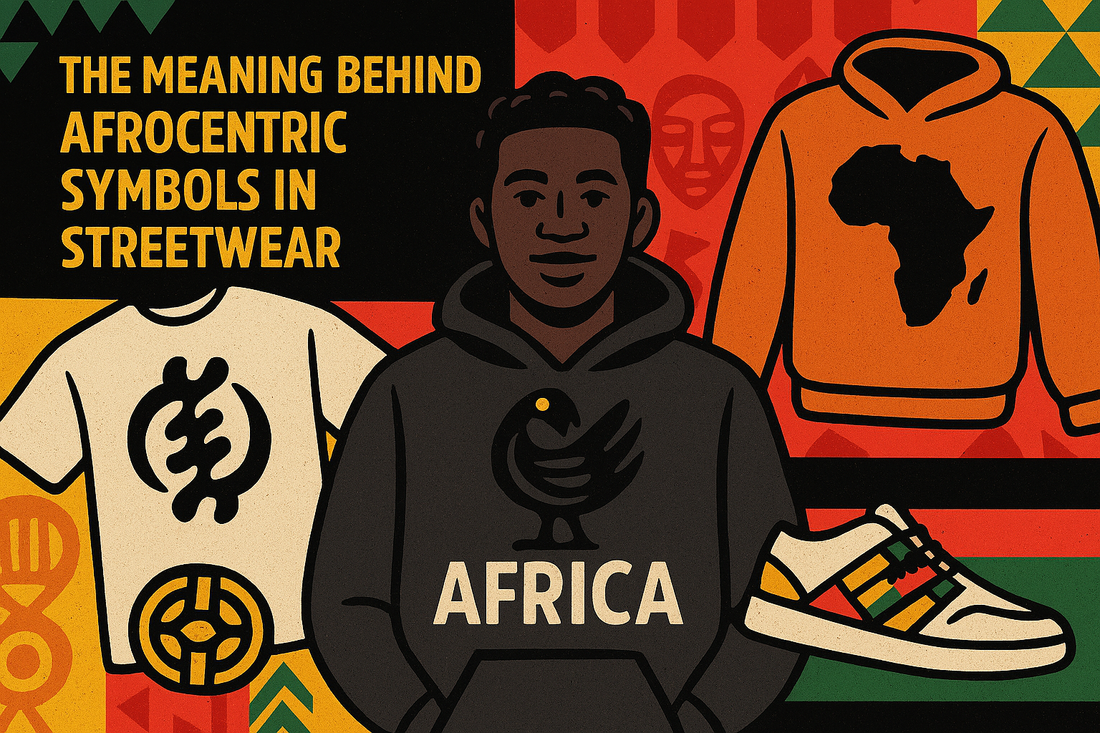
The Meaning Behind Afrocentric Symbols in Streetwear
Share
The Meaning Behind Afrocentric Symbols in Streetwear
Introduction
Fashion is not just fabric — it’s language. For centuries, clothing has carried unspoken codes of belonging, resistance, and identity. Nowhere is this truer than in Afrocentric fashion, where colors, patterns, and symbols are not just design choices but ancestral messages.
In the age of streetwear, those symbols have taken on new life. Hoodies, tees, and sneakers are no longer only casual wear; they’ve become canvases for culture. Today’s Afrocentric streetwear is a movement that keeps memory alive — reminding the world that Africa’s voice cannot be erased.
This article uncovers the deeper meanings behind the most powerful Afrocentric symbols appearing in streetwear today — from Adinkra icons and Pan-African colors to Kente patterns and maps of pre-colonial kingdoms. Understanding these symbols means understanding that Afrocentric fashion is not a passing trend, but a living archive stitched into style.
The Power of Symbols in Afrocentric Culture
Symbols in African culture have never been decoration alone. They are carriers of memory, spirituality, and resistance.
- In Ghana, the Adinkra system encodes proverbs into visual symbols.
- In West and Central Africa, masks serve as spiritual tools and guardians.
- Across the continent, colors hold sacred meaning — representing sacrifice, strength, and hope.
When these symbols appear on clothing, they do more than make a statement — they speak a story. Afrocentric streetwear continues this tradition, turning garments into loudspeakers of identity. What you wear becomes a declaration of who you are, where you come from, and what you refuse to forget.
Key Afrocentric Symbols in Streetwear
1. Adinkra Symbols (Ghana)
Perhaps the most recognized African iconography in modern design, Adinkra symbols are visual proverbs rooted in Akan culture. Each one carries a lesson or reminder from ancestors.
- Sankofa (Return and Get It): A bird reaching back for an egg on its back, symbolizing the importance of learning from the past to move forward. In streetwear, Sankofa often appears as a reminder of heritage and resilience.
- Duafe (Wooden Comb): Represents femininity, care, and community — a counterbalance to symbols of power, emphasizing balance and harmony.
- Gye Nyame (Except for God): A powerful spiritual emblem signifying divine supremacy and protection.
In streetwear, these symbols transform tees and hoodies into coded affirmations — a way of carrying ancestral wisdom into the present.
2. Pan-African Colors
Few symbols in Afrocentric fashion are as globally recognized as the red, black, green, and gold of the Pan-African flag. First popularized by Marcus Garvey and the UNIA in the early 20th century, these colors remain the foundation of African identity in design.
- Red: The blood of ancestors shed in struggle.
- Black: The people — the African diaspora united.
- Green: The land, fertility, and hope for renewal.
- Gold: Often added, representing wealth, light, and African abundance.
In streetwear, these colors aren’t just aesthetic choices. A hoodie outlined in red, black, and green is an anthem — a portable flag that declares unity across borders.
LoudThread’s “Diaspora Unbroken” design leans directly into these colors, making Pan-African identity impossible to ignore.
3. Kente Cloth Patterns
Originating from Ghana’s Ashanti kingdom, Kente cloth is one of Africa’s most symbolic textiles. Woven with bright patterns, each design has a name and meaning: unity, resilience, community, or remembrance.
While traditional Kente was once reserved for royalty and sacred ceremonies, modern streetwear reimagines it in jackets, sneakers, and graphic prints. The bold geometric patterns translate perfectly into contemporary design, making Kente a timeless link between heritage and modernity.
Today, wearing Kente-inspired streetwear is more than fashion — it’s carrying royalty into the streets.
4. African Masks & Tribal Patterns
Masks in African cultures are not costumes; they are sacred tools of transformation. Each mask represents spirits, ancestors, or deities, used in rituals to connect the visible and invisible worlds.
Streetwear often borrows from these motifs, using tribal linework, geometric designs, or mask silhouettes to evoke power, identity, and protection. When you see a hoodie with bold mask-inspired graphics, it’s not just style — it’s an echo of ceremonies that have kept cultures alive for centuries.
5. Maps of Africa & Pre-Colonial Kingdoms
One of the most powerful symbols in Afrocentric streetwear is simply the map of Africa. Worn boldly on tees, hats, and hoodies, the outline itself is a rejection of erasure. It says: We know where we come from, and we refuse to be disconnected.
Some designs go further, showcasing pre-colonial kingdoms — Mali, Songhai, Kush, Nubia — as a reminder that African history did not begin with colonization.
LoudThread’s “We Name Ourselves” design taps into this directly, rejecting imposed colonial borders in favor of names and places that predate European interference.
Streetwear as Modern Storytelling
Streetwear is the language of the youth — global, rebellious, and unapologetic. For the African diaspora, it is more than just urban fashion; it is modern-day storytelling.
Think of it as graffiti on fabric: every tee is a wall, every hoodie a mural. Afrocentric streetwear brings ancestral voices into conversations about identity, resistance, and survival.
During recent protests, Pan-African flags, Sankofa tees, and “I Am My Ancestors’ Wildest Dreams” hoodies weren’t just outfits — they were battle cries stitched into cotton. Streetwear becomes the megaphone when systems try to silence voices.
LoudThread’s Symbolic Edge
Many brands borrow Afrocentric symbols. LoudThread builds entire collections around them.
LoudThread is not just fashion — it is poetry you can wear. Each design is rooted in symbolism and language that pushes beyond surface-level aesthetics.
- Reparations Receipt → Styled like an invoice, it lists the incalculable debt of stolen resources and labor.
- We Name Ourselves → Rejects colonial boundaries and embraces pre-colonial maps.
- Afrocentric Leader Series → Celebrates ancestral leadership through design and storytelling.
By merging symbols with spoken-word energy, LoudThread positions itself as more than a clothing label. It becomes a cultural archive, ensuring that every stitch is both a style statement and a survival statement.
Conclusion
Afrocentric symbols in streetwear are more than design trends — they are ancestral codes translated into fashion. From Adinkra proverbs and Pan-African colors to Kente patterns and maps of Africa, each motif carries history, memory, and meaning.
Streetwear may have started in the concrete jungles of cities, but Afrocentric streetwear carries centuries of culture into the present. When you see these symbols walking the streets, you’re witnessing history alive and unbroken.
At LoudThread, every piece is created with that philosophy: clothing as resistance, poetry as design, fashion as rebellion. Because Afrocentric fashion is not a passing style — it’s a living movement.
Wear your story. Stay Loud.
👉 Explore the LoudThread collection at LoudThread.com
